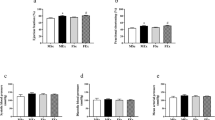Summary
To evaluate the effects of exercise on aortic wall elasticity and elastic components, young male rats underwent various exercise regimes for 16 weeks. In the exercised rats, the aortic incremental elastic modulus decreased significantly when under physiological strain. The aortic content of elastin increased significantly and the calcium content of elastin decreased significantly in the exercised group. The accumulated data from the exercised and sedentary groups revealed that the elastin calcium content was related positively to the incremental elastic modulus. We concluded that physical exercise from an early age decreases the calcium deposit in aortic wall elastin and that this effect probably produced in the exercised rats a distensible aorta.
Similar content being viewed by others
References
Bergel DH (1961) The static elastic properties of the arterial wall. J Physiol (Lond) 156:445–457
Bergman I, Loxley R (1969) Lung tissue hydrolysates. Studies of the optimum conditions for spectrophotometric determination of hydroxyproline. Analyst 94:575–584
Berry CL, Greenwald SE (1976) Effects of hypertension on the static mechanical properties and chemical composition of the rat aorta. Cardiovasc Res 10:437–451
Berry CL, Greenwald SE, Rivett JF (1975) Static mechanical properties of the developing and mature rat aorta. Cardiovasc Res 9:669–678
Blumenthal HT, Landing AI, Gray SH (1950) The interrelation of elastic tissue and calcium in the genesis of arteriosclerosis. Am J Pathol 26:989–1009
Burton AC (1954) Relation of structure to function of the tissues of the wall of blood vessels. Physiol Rev 34:619–642
Colandrea MA, Friedman GD, Nichaman MZ, Lynd CN (1970) Systolic hypertension in the elderly. An epidemiologic assessment. Circulation 41:239–245
Davidson JM, Hill KE, Alford JL (1986) Developmental changes in collagen and elastin biosynthesis in the porcine aorta. Dev Biol 118:103–111
Fleckenstein A, Frey M, von Witzleben H (1982) Vascular calcium overload — a pathogenic factor in arteriosclerosis and its neutralization by calcium antagonists. In: Kaltenbach M, Neufeld HN (eds) Proceedings of 5th International Adalat Symposium. Exerpta Medica, Amsterdam, pp 36–52
Fuwa K, Haraguchi H (1980) ICP emission spectroscopy. Nankohdo, Tokyo
Hayashi K, Washizu T, Tsushima N, Kiraly R, Nose Y (1981) Mechanical properties of aortas and pulmonary arteries of calves implanted with cardiac prostheses. J Biomech 14:173–182
Kannel WB, Wolf PA, McGee D, Dawber TR, McNamara P, Castelli WP (1981) Systolic blood pressure, arterial rigidity, and risk of stroke. The Framingham Study. JAMA 245:1225–1229
Kramsch DM, Aspen AJ, Apstein CS (1980) Suppression of experimental atherosclerosis by the Ca++ antagonist Lanthanum. Possible role of calcium in atherogenesis. J Clin Invest 65:967–981
Lansing AI, Rosenthal TB, Alex M, Dempsey EW (1952) The structure and chemical characterization of elastic fiber as revealed by elastase and by electron microscopy. Anat Rec 114:555–575
Lefevre M, Rucker RB (1980) Aorta elastin turnover in normal and hypercholesterolemic Japanese quail. Biochim Biophys Acta 630:519–529
Lefevre M, Rucker RB (1983) Modification of arterial elastin in vivo. Effects of age and diet on changes in the N-terminal amino acid content of aorta elastin. Biochim Biophys Acta 743:338–342
Leung DYM, Glagov S, Mathews MB (1976) Cyclic stretching stimulates synthesis of matrix components by arterial smooth muscle cells in vitro. Science 191:475–477
Masuda H, Saito N, Kawamura K, Shozawa T, Kanazawa A, Sageshima M (1987) Flow loaded canine carotid artery. II. Ultrastructural changes in the subendothelial layer. Acta Pathol Jpn 37:239–251
Matsuda M, Nosaka T, Sato M, Ohshima N, Fukushima H (1988) Effect of prolonged voluntary running on biochemical and biomechanical properties of rat aorta. J Jpn Coll Angiol 28:477–480
Matsuda M, Nosaka T, Sato M, Iijima J, Ohshima N, Fukushima H (1989) Effects of exercise training on biochemical and biomechanical properties of rat aorta. Angiology 40:51–58
Pickering GW (1968) High blood pressure. Churchill, London, pp 23–25
Roach MR, Burton AC (1957) The reason for the shape of the distensibility on curves of artery. Can J Biochem Physiol 35:181–190
Wiener J, Loud AV, Giacomelli F, Anversa P (1977) Morphometric analysis of hypertension-induced hypertrophy of rat thoracic aorta. Am J Pathol 88:619–634
Wolinsky H, Glagor S (1964) Structural basis for the static mechanical properties of the aorta media. Circ Res 14:400–413
Yu SY, Blumenthal HT (1963) The calcification of elastic fibers. I. Biochemical studies. J Gerontol 18:119–126
Author information
Authors and Affiliations
Rights and permissions
About this article
Cite this article
Matsuda, M., Nosaka, T., Sato, M. et al. Effects of physical exercise on the elasticity and elastic components of the rat aorta. Europ. J. Appl. Physiol. 66, 122–126 (1993). https://doi.org/10.1007/BF01427052
Accepted:
Issue Date:
DOI: https://doi.org/10.1007/BF01427052




